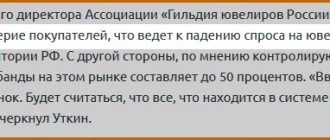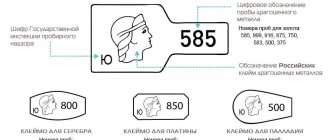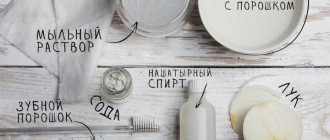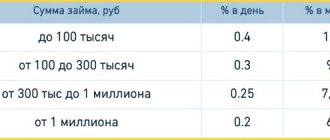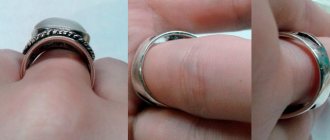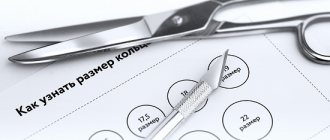Ways to check jewelry
The safest way to buy jewelry is through trusted brands and well-established jewelry stores . This is much more reliable than buying jewelry from hand, and you don’t have to experiment with chalk, iodine and other substances. But what if you are not sure about the quality?
Sample and stamp
This is the first thing you need to pay attention to when purchasing gold jewelry. Sample standards and hallmarks are regulated by the state, so this method of verification is beyond doubt. Each piece of jewelry has the hallmark of the Assay Office. You just need to arm yourself with a magnifying glass to examine the mark.
If the jewelry is dirty or damaged, and the mark cannot be seen, then it is better to refuse such a purchase.
Features of checking a gemstone for authenticity
Determining the quality characteristics is best done for a stone that is in loose form, since when assessing the parameters of a stone installed in a piece of jewelry, a significant error may occur. This error is minimal and does not exceed 5% in weight and 1 group of color and clarity for a stone with high quality cutting characteristics, set in the most open setting. But if the quality of the stone cut deteriorates, and it is set in a frame that impairs viewing and the ability to take measurements, and has mirrored, matte or colored surfaces, the error may increase.
How to distinguish real gold from fake?
By trial. On the precious metal you will see numbers that indicate the amount of pure metal in the composition. The rest of the composition is a ligature, that is, additives that give a certain color and properties. Most often in stores you can find jewelry made of 585 gold.
How to ensure quality:
- the sample must be applied clearly, there should be no unreadable letters, chips, or blurry numbers;
- It is better to examine the numbers with a magnifying glass to ensure full compliance;
- check that the sample on the jewelry matches the one indicated in the documents.
Inspect the product carefully . If it is new, then the metal should not have any defects, such as abrasions, scratches and cracks. As for jewelry that has already been used, they may have defects: scratches are natural for gold, as a fairly soft metal.
Consider the structure of the alloy : if the surface is not smooth, but porous, then this may be a sign of cheap metal or poor workmanship. It is better not to buy such an accessory. Inspect not only the outer surface, but also the underside. An indicator of high-quality work by a jeweler is a smooth inner surface without defects (poor polishing, snags, sharp corners).
How is gold different from gilding?
Relatively speaking, gilding is a coating “for show”. In other words, it can be any base metal (for example, steel or an iron-containing alloy) or, at best, silver coated with a thin layer of gold. Such things have a right to exist, but the buyer must be warned about what he is buying. Unfortunately, such items are often passed off as real gold, especially in popular tourist areas.
One of the well-known ways to detect gilding in field conditions is to use an ordinary magnet: bring the magnet to the jewelry, and if it is made of gold, it will not be magnetized
Copying jewelry: how to prevent theft and protect your collection from a legal point of view
As an industrial design in accordance with paragraph 1 of Art. 1352 of the Civil Code of the Russian Federation protects the appearance of a product of industrial or handicraft production. In other words, an industrial design patent provides legal protection to the design and appearance of a product. At the same time, for the purposes of registering a patent, it is necessary that the product, in its essential features, be new and original.
The patent holder, if there is information confirming the fact of illegal use of the protected appearance of a jewelry product, has the right to apply to the court with a demand to terminate actions that violate his exclusive right to the patent, as well as payment of compensation in the amount of 10,000 to 5,000,000 rubles, determined at the discretion of the court, based on the nature of the violation (Article 1406 of the Civil Code of the Russian Federation).
Do not forget that before sending a claim to the violator or filing a lawsuit in court, it is advisable to carry out a so-called test purchase, which will make it possible to prove that the violator introduced jewelry products into civil circulation in which the patented design was used. An industrial design is recognized as used in a product if it contains all the essential features of an industrial design or a set of features that produces on an informed consumer the same general impression as the patented industrial design produces, provided that the products have a similar purpose. If a violator places and offers for sale jewelry products on the Internet, it would be a good idea to contact a notary to draw up a notarial protocol for inspecting the site and certifying the relevant Internet pages. After collecting the evidence base, the patent holder must comply with the claim procedure for resolving disputes, which became mandatory in July 2021 (Federal Law of July 1, 2021 No. 147-FZ “On Amendments to Articles 1252 and 1486 of Part Four of the Civil Code of the Russian Federation and Articles 4 and 99 of the Arbitration Procedure Code RF") and only after that file a claim in court.
In practice, there are also often cases when patent holders, having taken care of providing legal protection to their product, are deprived of their exclusive right to an intellectual property item due to failure to pay annual fees for maintaining the patent in force. As an example, we can cite a patent for an industrial design under certificate No. 82938—a set of jewelry, the legal protection of which was terminated ahead of schedule on the specified basis. Another reason for these adverse consequences may be the case when the patent holder simply forgot to contact Rospatent with an application to extend the exclusive right to an industrial design, the validity period of which can be repeatedly extended by 5 years, but in general for no more than 25 years, counting from the date filing an application for a patent with the federal executive body for intellectual property.
Thus, in addition to the exclusive right to use the patent, the patent holder also has obligations established by law to maintain the validity of the registered intellectual property, failure to comply with which entails a limitation of the rights of its owner.
How to check the authenticity of silver
Silver is available to almost everyone, but even it is often counterfeited. There are several ways to help distinguish a precious metal from a cheap alloy. First of all, a test. The hallmark must be present even on designer handmade products. Other methods:
- Thermal conductivity . The noble metal is known for its high thermal conductivity, and therefore silver items heat up faster from the palm of your hand.
- Shine . If you place an item made of base metal next to silver jewelry, the former will better reflect light and shine.
- Sound . When something falls on a hard, flat surface, the sound will be thin and ringing, not dull.
- Chalk . As for how to check silver with chalk, it’s easy to do: rub the surface of the item with chalk - if the chalk turns black, then you can safely buy the item.
Testing with iodine or nitric acid is not recommended so as not to damage the product
How to check stones for authenticity at home
There are several ways to test stones at home. It is worth noting that they cannot be called the most reliable: the authenticity of stones can only be determined by a gemologist or laboratories that diagnose stones.
- Diamond . When purchasing, be vigilant: an item with a diamond must be accompanied by a tag indicating the characteristics. A crystal cannot be absolutely pure, unless it is an expensive product, so inspect it carefully: diamonds always have internal inclusions (tiny cracks, dots, stripes). The stone should shine equally from all sides. The edges of the diamond should be clear and even.
- Emeralds . Emeralds have poor thermal conductivity, so they should remain cold to the touch. If you examine the stone with a magnifying glass, there should be no spiral or tubular patterns in its structure.
- Sapphire . A blue stone is easy to check: the gem changes color at different angles.
Remember that the surest way to check jewelry is to buy from trusted stores or take the item to a jeweler. When purchasing, be sure to check for special marks: stamps and hallmarks. It is not recommended to purchase jewelry second-hand in popular tourist places.
29.07.20
Jewelry fakes
A chance for an avenger. Precious fakes
Counterfeits are rust that corrodes high jewelry style. The reason for counterfeits lies in two circumstances - the high cost of jewelry and the impossibility of identifying a precious alloy of the declared standard and a precious stone of the declared parameters by eye and touch.
How to avoid counterfeit jewelry? Of course, you need to fulfill the standard requirements - study the documents accompanying the product, check the stamp and name tag (these stamps are required by law on all jewelry in the Russian Federation). But the main means of identifying counterfeit purchases is your own awareness.
First, you should understand the difference between a fake and a counterfeit. A counterfeit is a product in which precious metal or precious stones are secretly replaced with cheap analogues, for example, glass is used instead of diamonds. Counterfeit is the illegal copying of a well-known design by a popular company. In this case, the product can be made from the proper jewelry alloy and from precious stones of the appropriate quality. The point of this business is not to deceive customers, but to exploit someone else’s positive reputation.
Secondly, you need to know that some of the jewelry on the Russian market is illegally produced. They are made in underground workshops. In this case, the product, as a rule, is made of full-weight gold and normal precious stones. Only the imprints of the State Assay Office are fake. The point of this business is not to deceive buyers or insult the Assay Office, but to evade taxes and the attention of law enforcement agencies (if unaccounted for gold and stolen diamonds are used).
Thirdly, high technology has entered the jewelry business en masse. They allow you to transform low-grade precious stones into seemingly noble ones. Many technologies are called “stone refining.” For example, thermal annealing is used to heal cracks in emeralds, rubies and sapphires. Thermobaric treatment transforms cheap brown diamonds into colorless ones. Ion plasma techniques (originally developed for the electronics industry) blacken diamonds to produce the fashionable black color. Laser machines are used to drill out dark inclusions in diamonds to enhance their apparent perfection. Split stones are glued together using special compounds.
According to international ethical standards, jewelers are required to inform customers about alterations made. However, this does not always happen: sellers are reluctant to reveal the secrets of pre-treatment of precious stones.
Fourthly, in the jewelry business there is such a form of fraud as overstating the characteristics of precious stones. The fact is that these important elements of jewelry, in addition to the mass of the stone, also have quality parameters, such as the color and purity of the stone. At the same time, the cost of, say, diamonds with the highest color and highest clarity (in Russia denoted as 1/1) differs several times from “gray mice” - diamonds with an unpleasant yellowish color and cloudy inclusions with parameters 5/6, 6/7. For example, a round diamond weighing 1 carat with parameters 1/1 is actually valued at retail at 2 million rubles, and with parameters 5/4 at 1 million rubles. The 1 million difference is a constant and often irresistible driving force for deception. By the way, it is the initially inflated characteristics of diamonds that explain the unrealistic discounts of up to 60% in some jewelry stores.
All counterfeits are divided into two types: counterfeit jewelry alloys and counterfeit precious stones.
Usually, for counterfeiting gold, silver and platinum, alloys of cheap metals - copper, zinc, tin - are used. When it comes to gemstones, common counterfeits include synthetic counterparts, colored plastics, and colored glass. For example, the production of synthetic (artificial) ruby in the USSR amounted to tens of tons. The diamond has a special position: in addition to such well-known fakes as rhinestones (lead glass) and cubic zirconia (zirconium dioxide), in recent years moissanite (silicon carbide) has appeared, indistinguishable even by the Diamond Tester.
Experts recommend the following “road map” for an unsure buyer: official examination by the Assay Inspectorate (this is the only government agency in the Russian Federation that carries out examination of both metals and stones); then an application to Rospotrebnadzor; Well, and then - the trial.
Finally, remember that counterfeits are a double-edged sword. There are known “people’s avengers” who make a business out of counterfeits: through a network of experts, they find expensive counterfeits in stores and buy them through straw buyers. Having carried out the appropriate examinations, the “avengers” blackmail the traders with court proceedings and publicity, and then, as part of a settlement agreement, receive substantial compensation.
